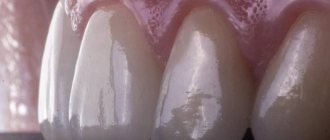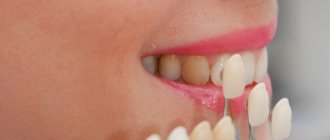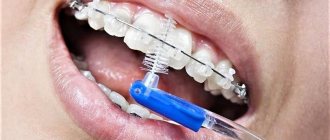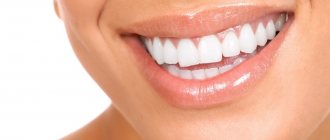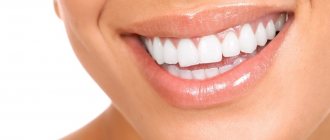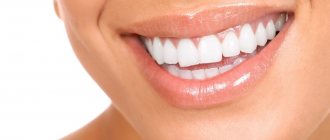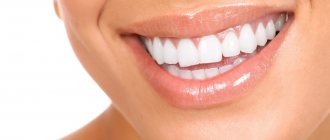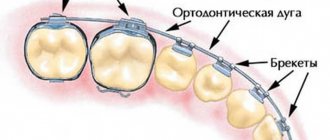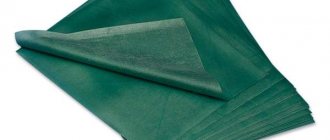Tooth dislocation is a displacement of the tooth position in one direction or another, the direction of which depends on the direction of the impact force (impact). Dislocations of primary teeth are approximately three times more common than similar injuries to permanent teeth; this is due to the lower stability of primary teeth in the jaw bone.
Not all situations can be foreseen; if an injury occurs, you need to remember that the treatment of each type of dislocation has its own characteristics, and seeking dental care as soon as possible increases the percentage of favorable outcomes.
Causes of dislocations
Dislocation always occurs under the influence of a directed force, the source of which is:
- a blow to the tooth during a game, a fall, a fight, an accident, an industrial accident;
- the load acting on the tooth when chewing bones, unshelled nuts, or opening beer bottles with the teeth;
- incorrect tooth extraction technique;
- pressure on a moving tooth when biting hard food.
When dislocation occurs, the position of the tooth root in relation to the walls of the socket changes, periodontal fibers are completely or partially torn, and the neurovascular bundle is damaged; often a dislocation is combined with a fracture of the tooth crown or maxillofacial injuries. Based on the nature of tooth displacement, incomplete, complete and impacted dislocations are distinguished.
The final stage of transposition treatment - making teeth beautiful
This was followed by the long-awaited getting rid of the braces system, cleaning and polishing of the teeth and the manufacture of fastening devices - retainers. A removable transparent night guard (aligner) was made for the upper jaw, and a non-removable wire retainer from canine to canine was made for the teeth of the lower jaw. Control examinations are recommended every six months for several years.
Conclusions of orthodontist Alexey Trezubov:
- Orthodontic treatment of tooth transposition should be considered as the preferred method of treatment.
- When planning treatment, it is important to take into account the patient’s age, degree of transposition, location of the roots, thickness of the bone tissue in the area of displacement and gum biotype.
- If the orthodontic method of correction is considered inappropriate, then other methods of correction are used.
- During such a rather complex movement of teeth, the orthodontist must be very careful and attentive, monitor the situation at each visit and make the necessary changes.
- The prognosis for treatment of such patients is in most cases favorable, but do not forget about the retention period.
Symptoms and treatment of dislocations
Incomplete dislocation
With incomplete luxation, the tooth changes its position in the dentition in some direction, and its root moves. The tooth becomes mobile, patients experience pain that intensifies when eating. The gums around the dislocated tooth swell and bleed slightly. Due to the incorrect position of the tooth, the patient cannot close his jaw and keeps his mouth slightly open.
Treatment for incomplete dislocation of a permanent tooth consists of repositioning, that is, installing the tooth in its normal position. The manipulation is performed after applying local anesthesia: the dentist wraps his fingers around the dislocated tooth and carefully returns it to its place. After this, splinting is performed - a splint is installed on the injured and adjacent teeth, which fixes the tooth in the correct position and protects it from stress.
After installing the splint, the viability of the pulp is determined; if it dies as a result of a strong blow, depulpation is carried out.
Treatment for an incompletely luxated primary tooth with minor displacement involves returning the tooth to its correct position and monitoring the patient. If the tooth is severely displaced, it must be removed.
Complete dislocation
Complete luxation – loss of a tooth from its socket; patients experience severe pain, the socket bleeds, there are often wounds or bruises on the face, or traumatic brain injury.
Patients often believe that if a traumatic tooth loss occurs, nothing can be done. But there is a chance of restoring a lost tooth using the replantation method - with prompt action by the patient and the doctor, the tooth returns to the socket. This applies only to permanent teeth; replantation of milk teeth is not carried out.
The success of the operation depends on the correct behavior of the patient:
- the knocked out tooth needs to be found;
- place in a medium close to physiological (sodium chloride solution 0.9%, milk); In this case, the tooth cannot be wiped or touched by the root;
- come to the dentist immediately.
Reducing the time period from the moment of injury to replantation increases the chances of tooth engraftment. When a permanent tooth with formed roots is completely dislocated, the pulp dies, so it is removed some time after replantation. Sometimes the pulp is removed before the tooth is returned to its socket.
The pulp of teeth with an unformed root has the property of revascularization - restoration of blood vessels in it, therefore, when replantation is carried out as soon as possible after injury, it is possible to preserve the viability of the pulp. If this does not happen, depulpation is performed.
If replantation is not possible, after the hole has healed, prosthetics are performed to restore the integrity of the dentition. Prosthetics in childhood are performed if there is a recommendation from an orthodontist, under whose supervision the child must be kept after tooth loss.
Impacted dislocation
This type of dislocation is characterized by the immersion of the tooth into the socket, while the root penetrates into the bone tissue of the jaw, destroying the bottom of the alveolus. The tooth may be displaced away from its axis; traumatic injuries to adjacent teeth and oral mucosa are often detected; Traumatic brain injury may be present. Severe pain, swelling of the gums, and bleeding appear. Sometimes the tooth is driven in so deeply that it is not visually identified in the socket.
Treatment of impacted dislocations depends on whether the temporary or permanent tooth was injured. Temporary teeth with unformed roots with a small degree of intrusion can independently fall into place. If the teeth do not move forward within six weeks, they are removed. Injured baby teeth with formed roots are also removed.
If a permanent tooth with an unformed root is injured, it can also move into place on its own. If this does not happen, the tooth is placed in the correct position using orthodontic appliances. Reposition of teeth with a formed root is carried out immediately after injury or within 3 days, followed by splinting; It is possible to stretch the tooth using orthodontic appliances.
How to correct an overbite
Orthodontic treatment is carried out at different ages, but it is easier and faster in children. For adults, it takes longer to correct abnormal teeth alignment. The milk bite is also subject to correction. Although it will be replaced over time, permanent teeth grow in the place of their predecessors. Modern methods of bite correction are safe. They cause the patient only minor discomfort.
The doctor carefully studies the problem, assesses the condition of the oral cavity (if necessary, it is sanitized) and develops a treatment regimen. One of the following designs can be used in the process:
- Bracket systems. There are different types. They differ in aesthetic qualities, installation methods and prices. Such orthodontic structures will help correct almost any disorder.
- A mouthguard is a polymer product made from an individual impression. Easily removable, which is necessary for eating and brushing teeth.
- Records. The most effective designs for correcting primary malocclusion. They can also be given to adults, but this will not be the main treatment.
In complex cases (congenital pathologies), surgical intervention is required. Sometimes auxiliary techniques are used. Treatment of tooth wear in a “reducing bite,” in which dental tissue wears down with age, is carried out through prosthetics with crowns or veneers.
Remember! Correcting your bite is not only about getting a beautiful smile, but also a significant contribution to your health. Entrust the solution to your problem to a specialist. He knows how to check the bite for abnormalities. If they are identified, the correction will be carried out competently.
Methods for diagnosing dislocations
When diagnosing dislocations, the following methods are used:
- Questioning the patient - the circumstances of the injury and the time when it occurred are clarified. The patient describes his feelings and complaints.
- External examination - the doctor assesses the general appearance of the patient, notes damage to the soft tissues of the face that occurred as a result of injury. The dentist may be the first to notice signs of a traumatic brain injury in a patient: pallor, sluggish reaction, weakness, respiratory rhythm disturbances.
- Examination of the oral cavity using a dental probe and a dental mirror. The mirror allows you to see areas that are not accessible to direct visual inspection. With the help of a probe, in case of incomplete dislocation, the depth of the periodontal gap is determined.
- Percussion - tapping on the tooth, helps determine the condition of the periodontium. In case of incomplete dislocation, percussion of the injured tooth causes acute pain; with impacted dislocation, percussion is painless or slightly painful.
- Palpation - feeling. Palpation of the gums with impacted dislocation is painful; Using this method, the dentist distinguishes incomplete dislocation from a root fracture.
- EDI – electroodontodiagnostics – determines the electrical excitability and conductivity of the pulp. A current of a certain strength is passed through the tooth using a special apparatus, and the patient is asked to report the tooth’s reaction to electrical impulses. If the pulp is viable, a slight feeling of pain appears in the tooth; When the pulp dies, there is no pain, the patient will feel a push in the tooth. During diagnosis, the threshold response of the tooth to current is recorded; in the normal state of the pulp, it is within the range of current readings from 2 to 6 μA.
Immediately after the injury, the pulp may not react to the action of the current, so tests are carried out 2-3 days after it, then every week for 4 weeks, sometimes longer. This is explained by the fact that while maintaining the viability of the pulp in case of dental trauma, its electrical sensitivity can be restored for a long time.
- X-ray examination - allows you to assess the condition of the roots of the tooth, periodontium, alveolar walls, jaw bone after injury; see the degree of tooth displacement after dislocation. It is preferable to carry out 3D computed tomography, since this method allows you to view the tooth and jaw bones in three projections, eliminating the effect of overlapping images.
- Transillumination diagnostics - transillumination of the tooth with a beam of cold light. Used to detect enamel cracks that cannot be detected with the naked eye. The method helps to maintain the health of teeth adjacent to the injured one, and at first glance not damaged during the injury.
Types of diastemas
How the gap between the teeth can be removed depends on the reasons why the gap appeared. Therefore, it is very important to correctly identify the species. Diastemas are classified according to three main characteristics:
- By time of occurrence of the defect
:- False
. It is diagnosed in children when the bite is not yet fully formed. The problem disappears on its own without third-party intervention after replacing baby teeth with permanent ones. - True. Diagnosed in adolescents and adults in the period after the formation of the bite. It occurs due to periodontal pathologies, injuries or the absence of some frontal teeth in a row.
- By location
:- Symmetrical
. The location is determined relative to the conditional center of the dentition (usually oriented along the frenulum). The position of the incisors relative to each other is also taken into account. - Asymmetrical
. Most often, one of the incisors is in its place, and the second is deviated relative to the conditional center. - According to the position of roots and teeth
:- Literal deviation of crowns
. The defect is most often observed in people with a superset of teeth. In this case, the position of the roots is correct, but the incisors themselves deviate. Usually the gap in this case is no more than two millimeters. - Hull literal offset
. A common cause of the defect is excessively compacted bone tissue of the middle suture, which does not allow teeth to erupt in the place where they are needed. It is expressed in the lateral displacement of both the root and the incisor. - Medial tilt
. The most complex defect that can occur with the central incisors. As in the previous case, teeth and roots shift, but they can grow not only to the sides, but also with a displacement around their own axis.
To understand how to remove the gap between the front teeth and which method is best to choose, the dentist must correctly determine the type of diastema. Keep in mind that it is impossible to get rid of a gap on your own or at home - you cannot do this without the help of a specialized doctor.
Additional treatments
Drug therapy
- When carrying out manipulations to reposition a tooth after dislocation, local anesthesia is used, for this purpose Ultracaine D-S, Ultracaine D-S Forte, Cytokartin, Septanest, Bupivacaine are used. But the effect of the anesthetic stops after some time, so painkillers from the NSAID group are prescribed: ibuprofen, nimesulide, ketorolac, dexketoprofen. Children are prescribed ibuprofen and paracetamol.
- To improve the condition of the gums after injury, use: Dentol Gel - has a local anesthetic effect.
- Gel Metrogyl Denta - contains two antibacterial components, eliminates inflammation.
- Kamistad gel is a combined drug: lidocaine has a local anesthetic effect, chamomile flower tincture produces antiseptic and anti-inflammatory effects, thymol has an antiseptic effect.
- Solcoseryl dental paste - stimulates regeneration processes in tissues, thereby shortening the healing period of wounds of the mucous membrane. The composition also includes polidocanol, a local anesthetic.
Physiotherapy
After acute phenomena have subsided, the following are used to stimulate healing processes and eliminate tissue swelling:
- UHF therapy is the effect on the body of an alternating electric field with ultra-high frequency.
- Microwave therapy – uses alternating electromagnetic oscillations of ultra-high frequencies of various ranges (centimeter, decimeter and millimeter).
- Magnetotherapy is the effect of a low-frequency magnetic field on the injured area.
- Magneto-laser therapy is a complex effect of magnetic and laser radiation.
Is it necessary to remove a loose tooth?
In some situations this procedure cannot be avoided, but the main thing here is not to rush. Before drawing up a treatment plan, the dentist conducts an in-person diagnosis - examines the oral cavity, takes X-rays and studies the condition of the roots. The less damage is detected, the greater the chances of successful prosthetics. You won’t be able to do without deletion if:
- pronounced mobility;
- the infectious process is severely advanced.
At the same time, patients at dental clinics should understand that doctors are doing everything possible to maintain the integrity of their bite. Therefore, it is important to trust your doctor and strictly follow all his instructions. This approach will allow you to get excellent results in a short time.
Prevention
Prevention of tooth dislocation includes:
- Explanatory work with employees of industries associated with increased injuries. Each employee is required to comply with safety regulations, which provide for an algorithm for performing certain actions and the use of protective devices.
- Explaining to parents and children the rules for arranging playgrounds and behavior on them, familiarizing themselves with possible types of injuries and methods of providing first aid if they occur. Parents should supervise young children during play.
- Educational work among the population about the need to comply with traffic rules by drivers and pedestrians, as this is necessary not only to reduce the level of injuries, but also to save lives.
- Compliance by medical personnel with the rules for performing dental procedures.
- Avoiding bad habits: you need to use special tools to open bottles and crack nuts.
- Avoiding situations that could lead to a fight; if it does occur, during it you need to tense your masticatory muscles and keep your teeth closed: this will help avoid not only dislocation of teeth, but also a fracture of the jaw.
- Providing a high level of protection for athletes involved in traumatic sports (hockey, boxing). For this purpose, helmets with full face protection and mouth guards are used (molded, which have a ready-made shape, and molded - after heating in hot water, they take the individual shape of the teeth).
How to save a loose tooth
Medical tactics depend on the diagnosis. The patient is asked to undergo X-ray diagnostics. This is the best way to study the origins of the problem. From the images, the doctor can determine the degree of destruction of bone tissue and, based on the information received, decide what to do next. If periodontitis is to blame, dental plaque is removed. It is especially important to thoroughly clean the periodontal pockets and interdental spaces. It is best to remove stones using ultrasound. This method is safe and does not cause serious discomfort.
Additionally, the client is prescribed an antibacterial drug. This is necessary to quickly relieve the inflammatory process. If there is significant root destruction, splinting may be required. During the procedure, the dentist drills a small groove on the surface of adjacent teeth and places a miniature fiberglass splint into it. Afterwards, the cavity is closed with a filling compound. This measure makes it possible to securely fix the movable unit and avoid its removal in the coming years. If your teeth are loose due to bruxism - involuntary grinding at night - it is necessary to make a custom night guard. The patient should put it on every time before going to bed. In parallel, he is prescribed a course of vitamin-mineral medications and anticonvulsants. Dentists are asked to pay special attention to oral hygiene. Without it, dental health is impossible. To prevent the accumulation of stone, you need to use dental floss, an irrigator, and special interdental brushes. Moreover, this should be done not from time to time, but daily.
